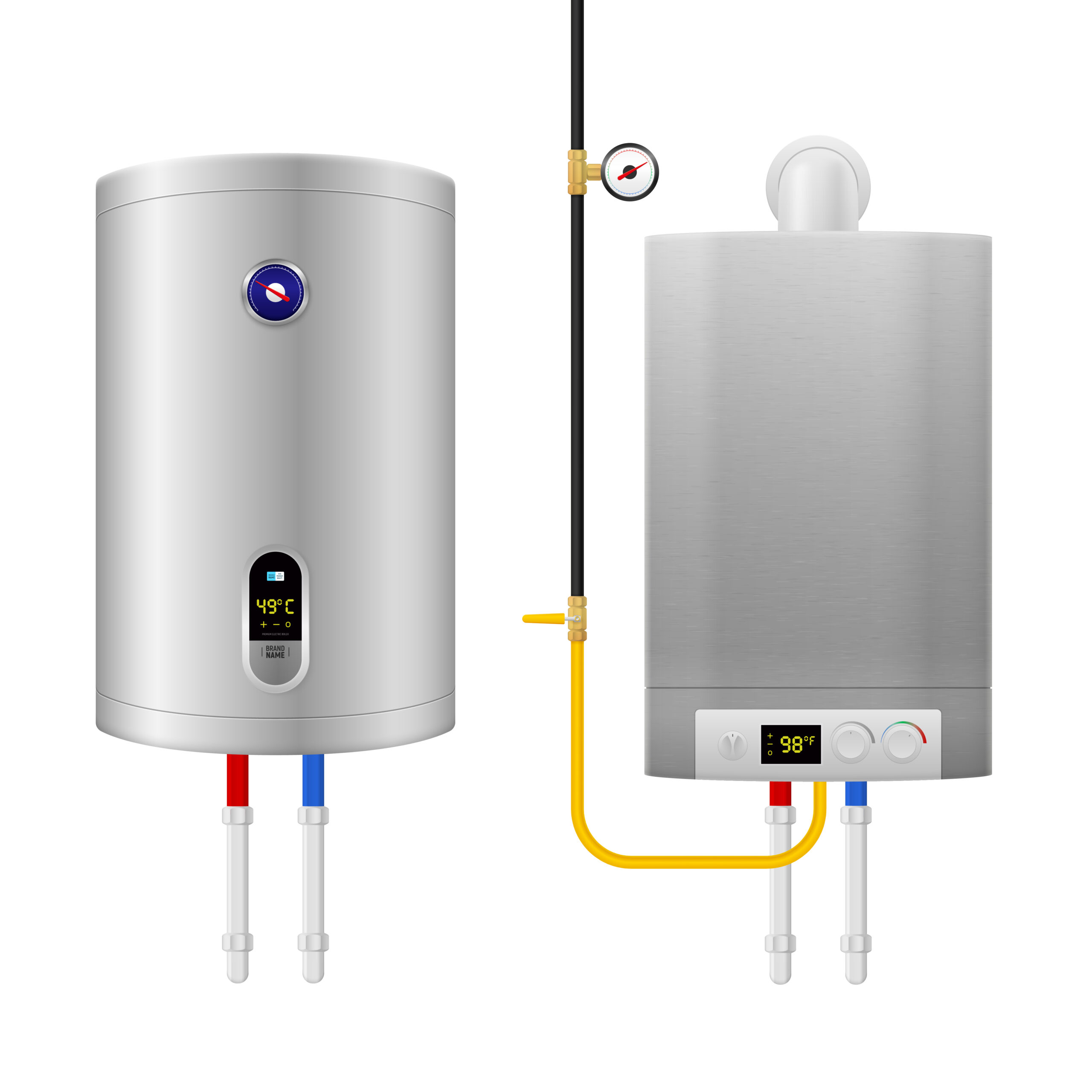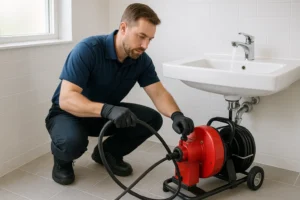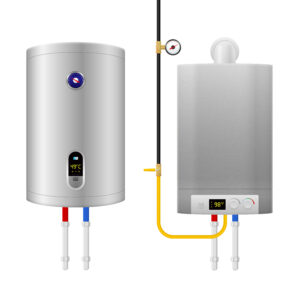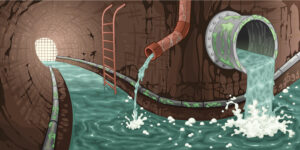|
Getting your Trinity Audio player ready...
|
Choosing the right water heater for your home is a decision that affects your daily comfort, energy bills, and long-term home maintenance costs. With traditional tank water heaters and modern tankless systems both offering distinct advantages, homeowners often find themselves weighing multiple factors before making this important investment.
In this comprehensive guide, we’ll explore the key differences between tank and tankless water heaters, helping you determine which option best suits your household needs, budget, and lifestyle.
Understanding the Basics
Traditional Tank Water Heaters
Tank water heaters, also known as storage water heaters, have been the standard in American homes for decades. These systems store and continuously heat 30 to 80 gallons of water in an insulated tank, keeping hot water ready for use at any time. When you turn on a hot water tap, heated water is released from the top of the tank and replaced by cold water at the bottom, which is then heated.
Tankless Water Heaters
Tankless water heaters, sometimes called on-demand or instantaneous water heaters, don’t store hot water. Instead, they heat water directly as it flows through the unit. When you open a hot water tap, cold water travels through a pipe into the unit where either a gas burner or electric heating element heats the water instantly. This provides a constant supply of hot water without the need for a storage tank.
Initial Cost Comparison
One of the first considerations for most homeowners is the upfront investment required for each system.
Tank Water Heater Costs
Traditional tank water heaters are generally more affordable initially. The unit itself typically costs between $500 and $1,500, depending on capacity and fuel type. Installation costs are usually straightforward, ranging from $500 to $1,000, as most homes already have the necessary infrastructure. The total investment for a tank water heater usually falls between $1,000 and $2,500.
Tankless Water Heater Costs
Tankless systems require a larger upfront investment. The unit alone can cost between $1,000 and $3,000 or more. Installation is more complex and expensive, often requiring upgrades to your home’s electrical system, gas lines, or venting. Professional installation typically costs $1,500 to $3,000 or higher. Overall, you’re looking at a total investment of $2,500 to $6,000 or more for a tankless system.
If you’re considering upgrading to a tankless system, professional tankless water heater installation ensures your unit is properly sized and configured for optimal performance.
Energy Efficiency and Operating Costs
While initial costs matter, long-term operating expenses significantly impact your total investment over the life of the system.
Tank Water Heater Efficiency
Traditional tank water heaters continuously heat and reheat water to maintain temperature, even when you’re not using hot water. This phenomenon, called standby heat loss, makes them less energy efficient. Most tank heaters have an energy factor rating between 0.58 and 0.65, meaning 58-65% of the energy they consume actually heats water.
Monthly operating costs for a tank water heater typically range from $30 to $50, depending on your fuel type, local utility rates, and usage patterns. While newer high-efficiency tank models offer better performance, they still can’t match the efficiency of tankless systems.
Tankless Water Heater Efficiency
Tankless water heaters only heat water when needed, eliminating standby heat loss entirely. They boast energy factor ratings between 0.82 and 0.94, making them significantly more efficient. For homes that use 41 gallons or less of hot water daily, tankless heaters can be 24-34% more energy efficient than tank models.
This efficiency translates to monthly operating costs of approximately $20 to $35, potentially saving you $10 to $20 per month compared to tank systems. Over the 20-year lifespan of a tankless heater, these savings can total $2,400 to $4,800, helping offset the higher initial investment.
Lifespan and Maintenance
The durability and maintenance requirements of your water heater affect both your long-term costs and convenience.
Tank Water Heater Lifespan
Traditional tank water heaters typically last 10 to 15 years with proper maintenance. The constant exposure to water gradually corrodes the tank interior despite protective measures like anode rods and glass linings. Regular maintenance includes flushing sediment buildup, checking the pressure relief valve, and replacing the anode rod every few years.
When a tank water heater fails, it often requires complete replacement. Leaking tanks can cause significant water damage to your home, making early detection crucial. If you notice any signs of tank deterioration, professional water heater inspection and service can help prevent costly damage.
Tankless Water Heater Lifespan
Tankless water heaters have a considerably longer lifespan, typically lasting 20 to 30 years or more with proper care. Without a storage tank to corrode, these systems face fewer structural failure risks. Regular maintenance involves annual descaling, especially in areas with hard water, and cleaning the inlet filter.
While tankless units are more durable overall, hard water can be particularly problematic. Installing a water softener service alongside your tankless heater protects the unit from mineral buildup and extends its operational life.
Hot Water Supply and Performance
How each system delivers hot water affects your daily comfort and household functionality.
Tank Water Heater Performance
Tank water heaters provide a large volume of hot water immediately but have a finite supply. Once you’ve depleted the tank’s contents, you must wait 30 to 60 minutes for the system to reheat a full tank. This recovery time can be frustrating during high-demand periods, such as when multiple family members need showers in quick succession or when running the dishwasher while someone bathes.
However, tank systems can supply multiple fixtures simultaneously without temperature fluctuation, as long as the stored hot water lasts. A family of four typically needs a 50 to 80-gallon tank to meet their hot water demands comfortably.
Tankless Water Heater Performance
Tankless water heaters provide unlimited hot water, as they heat water on demand indefinitely. You’ll never run out of hot water, making them ideal for large families or homes with high hot water usage. However, they have a maximum flow rate, typically 2 to 5 gallons per minute for residential units.
If multiple fixtures demand hot water simultaneously, the system might struggle to maintain temperature at all outlets. For example, running the dishwasher and shower at the same time might result in lukewarm water at both locations. Larger homes may need multiple tankless units or a higher-capacity model to handle simultaneous demands effectively.
Space Requirements and Installation
The physical footprint and installation complexity differ significantly between these two systems.
Tank Water Heater Installation
Tank water heaters are bulky, typically measuring 60 inches tall and 24 inches in diameter. They require a dedicated floor space in your basement, garage, utility room, or closet. This large footprint can limit storage space or affect room layouts in smaller homes.
Installation is relatively straightforward for replacements, as the infrastructure usually exists. Most tank installations can be completed in a few hours by experienced professionals providing residential plumbing services.
Tankless Water Heater Installation
Tankless water heaters are compact, often about the size of a small suitcase, and mount on walls. This space-saving design frees up valuable floor space and allows installation in locations where tank heaters wouldn’t fit, including closets, crawl spaces, or even outdoors in mild climates.
However, installation complexity is greater. Gas tankless heaters require proper venting, potentially needing new vent pipes through your roof or wall. Electric models might require electrical panel upgrades and dedicated circuits. These modifications increase installation time and cost but result in a more flexible and space-efficient system.
Environmental Impact
For environmentally conscious homeowners, the ecological footprint of your water heater matters.
Tank Water Heater Environmental Considerations
Tank water heaters consume more energy due to standby heat loss, resulting in higher carbon emissions over their operational life. They also have a shorter lifespan, meaning more units end up in landfills. However, they’re easier to recycle, and their simpler technology makes them accessible for repair rather than replacement in some cases.
Tankless Water Heater Environmental Benefits
Tankless water heaters’ superior energy efficiency significantly reduces your home’s carbon footprint. Their longer lifespan means fewer units manufactured and discarded over time. The reduced energy consumption can lower your household’s annual CO2 emissions by 300 to 500 pounds compared to tank systems.
Additionally, tankless heaters often qualify for federal tax credits and local utility rebates, recognizing their environmental benefits and encouraging their adoption.
Climate and Location Considerations
Your geographic location and climate affect water heater performance and efficiency.
Cold Climate Challenges
In regions with very cold winters, incoming groundwater temperatures can drop significantly, requiring water heaters to work harder. Tank heaters maintain consistent performance regardless of inlet water temperature because they continuously heat stored water. However, their energy consumption increases in winter.
Tankless heaters must heat colder incoming water instantly, which can reduce their flow rate or require a more powerful unit. In areas where groundwater regularly drops below 50°F, you might need a larger tankless unit or multiple units to maintain adequate hot water supply.
Hard Water Concerns
Areas with hard water pose maintenance challenges for both systems, but particularly for tankless heaters. Mineral deposits accumulate faster in tankless units, requiring more frequent descaling maintenance. Without proper treatment, hard water can significantly reduce a tankless heater’s lifespan and efficiency.
Installing a water filtration system or water softener protects your investment and ensures optimal performance, especially with tankless systems.
Household Size and Usage Patterns
Your family’s hot water consumption patterns should guide your decision.
Best for Small Households
Smaller households with one or two people typically use less hot water and rarely deplete a tank system’s supply. However, they also benefit significantly from tankless efficiency, as minimal hot water usage means maximum energy savings. The unlimited hot water capability might be unnecessary, but the space savings and efficiency make tankless attractive for smaller homes and apartments.
Best for Large Families
Families with three or more members face competing priorities. Large tank systems can handle simultaneous usage better initially but require strategic scheduling to avoid running out of hot water. Tankless systems provide unlimited supply but might need multiple units or higher capacity to serve several fixtures simultaneously.
Large families using 80+ gallons of hot water daily benefit most from tankless efficiency, potentially saving $200-$300 annually on energy costs compared to tank systems.
Common Problems and Repairs
Understanding potential issues helps you anticipate maintenance needs and costs.
Tank Water Heater Issues
Common tank water heater problems include sediment buildup reducing efficiency, failing heating elements or thermostats, corroded tanks causing leaks, and faulty pressure relief valves. Most repairs cost between $150 and $500, with tank replacement being the most expensive issue.
Regular flushing and anode rod replacement can prevent many problems. If you experience reduced hot water supply, unusual noises, or visible corrosion, prompt water heater servicecan address issues before they escalate.
Tankless Water Heater Issues
Tankless systems may experience mineral buildup requiring descaling, ignition failures in gas models, flow sensor problems, and occasional error codes requiring professional diagnosis. Repairs typically cost $150 to $600, depending on the issue.
The digital controls and sensors in tankless systems require specialized knowledge for troubleshooting and repair. Regular professional maintenance, including annual descaling and system checks, prevents most problems and maintains efficiency.
Making Your Decision: Key Factors to Consider
Choosing between tank and tankless water heaters depends on multiple factors specific to your situation.
Choose a tank water heater if:
- You want the lowest upfront cost
- Your home has limited electrical capacity or gas line size
- You have adequate space for installation
- You prefer simpler, more familiar technology
- Multiple fixtures regularly need hot water simultaneously
- You plan to stay in your home for less than 10 years
Choose a tankless water heater if:
- You want maximum energy efficiency and lower operating costs
- You need space-saving installation options
- You use hot water frequently or unpredictably
- You want the longest possible lifespan
- You’re environmentally conscious
- You’re planning long-term home improvements
- You qualify for tax credits or rebates
Professional Installation and Service Matters
Regardless of which system you choose, professional installation and regular maintenance are critical for optimal performance, safety, and longevity. Improper installation can void warranties, reduce efficiency, create safety hazards, and lead to premature system failure.
For tank systems, proper sizing, secure connections, correct pressure settings, and adequate venting ensure reliable operation. For tankless systems, proper electrical or gas line sizing, correct venting configuration, adequate water flow, and proper placement maximize efficiency and performance.
If you’re experiencing issues with your current water heater, from inconsistent temperatures to complete failure, or if you’re ready to upgrade to a more efficient system, professional emergency plumbing services can address urgent needs quickly and safely.
To Summarize: The Best Choice for Your Home
There’s no universally “best” water heater—the right choice depends on your specific circumstances, priorities, and budget. Tank water heaters remain an excellent, economical choice for many homes, especially when upfront costs are the primary concern or when home infrastructure limitations exist. Their familiar technology, widespread availability, and lower initial investment make them a practical default option.
Tankless water heaters represent the future of residential water heating, offering superior efficiency, longer lifespan, and unlimited hot water. While the higher upfront investment requires consideration, the long-term savings, environmental benefits, and performance advantages make them increasingly attractive, especially for new construction or major renovations.
Before making your decision, consider:
- Your household’s daily hot water consumption
- Available space for installation
- Your budget for both purchase and long-term operation
- How long you plan to stay in your home
- Local utility rates and available rebates
- Your home’s existing infrastructure
Consulting with experienced plumbing professionals helps you assess your specific needs, evaluate your home’s compatibility with each system, calculate actual costs including installation, and make an informed decision that serves your household well for years to come.
Whether you choose traditional or tankless technology, investing in quality equipment and professional installation ensures reliable hot water, optimal efficiency, and peace of mind. Your water heater is a crucial home system that deserves careful consideration and expert care throughout its operational life.




